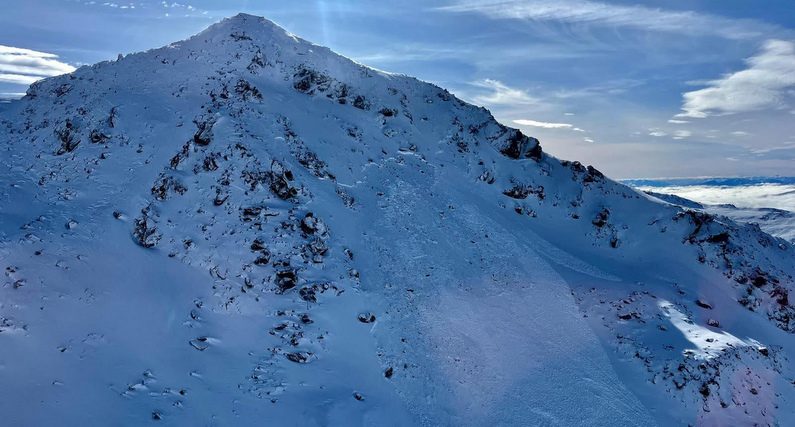
A remarkable avalanche response
Just before midday on 5 August 2023, two snowboarders triggered a huge avalanche beyond the boundary of The Remarkables Ski Area. Experts later assessed the avalanche at size 3.5; which means more than 10,000 cubic metres of debris with the power to destroy cars and small buildings.
A significant number of people and resources were rapidly deployed to search the debris. Although responders discovered that no one had been buried, the speed and effectiveness of the search demonstrated the readiness of the sector to respond to an incident like this.
Most avalanches involving people happen away from ski areas or cell phone coverage. This makes avalanche SAR operations like this extremely rare: there were only seven recorded since 2015.
Russ Tilsley, coordinator of the Wakatipu Land Search and Rescue – Alpine Cliff Rescue team happened to be nearby when the slide happened. “It's a popular ski touring area, and we’d seen ten or more people in the area when the slope avalanched,” said Russ. He sent one of his friends to a nearby ridge line to call the Police, and then began a search of the debris using avalanche transceivers. One person was partially buried, but had dug themselves out by the time Russ and his companion arrived.
Sergeant Terry Wood, of Queenstown Police SAR squad, received the call and activated the avalanche response readiness plan. “People on-site hadn't got any transceiver signals from beneath the debris, but with so many others in the area, it was impossible to know if someone without a transceiver had been buried,” says Terry. “Because survival is so time-critical, the plan calls for us to activate a range of resources, very quickly.”
The avalanche experts at The Remarkables Ski Area were near the top of the calling list. “Within minutes of the call, we had two patrollers heading up a lift, to ski over the ridgeline to the scene,” says Will Rowntree, Snow Safety Officer for Remarkables Ski Patrol. Soon afterwards, the first helicopter arrived to take Will plus a colleague and his dog to the scene. “Avalanche Dogs are trained to sniff out a buried person, providing the best chance of survival if that person wasn’t wearing an avalanche transceiver.”
Following the readiness plan, Will took the role of Avalanche Site Commander. “We flew around the avalanche site, to properly understand the situation. Russ was pretty sure there were no transceiver signals, but considering the size of the event and the numbers of people nearby, there was no concrete evidence that no-one was buried. So we had to run the system.”
Soon personnel and dog teams from Cardrona Ski Patrol arrived by helicopter, and Will coordinated the progressive clearance of the site. First with avalanche transceivers, then with the RECCO system (which detects radio signal reflections from a small metal-lic tag sewn into snow clothing) and then avalanche dogs. “The dog teams are our only viable option to find people who are buried who are not wearing a transceiver or RECCO clothing.”
“We swept the entire site with all three dogs, then specifically in the higher probability terrain areas,” says Will. “About an hour and forty minutes after being called, we declared the site clear.”
Communications were challenging on site. Radios on the search and rescue channel provided comms between operational teams, but Will needed to use the Remarkables digital radio network to reach back to the Incident Management Team at the ski area base.
At the post-operation debrief, there were a few suggestions for improvement. Some phone calls pre-empted the planned infor-mation flow, which led to some double handling of data. However, all involved agreed that overall the response was extremely well conducted.
Because avalanche SAR operations are so rare, Will consid-ered this event a career highlight. He presented on the operation at the Southern Hemisphere Alpine Conference, held in Wanaka, in mid-June.
Resources for Avalanche responders
The New Zealand Avalanche Search and Rescue Readiness Guidelines are available to download from nzsar.govt.nz
The guidelines were significantly updated in 2022 with funding support from NZSAR and extensive consultation with the New Zealand and international avalanche industry. They aim to assist response agencies with developing and improving their own readiness plans.
The NZ Avalanche Advisory is delivered by the Mountain Safety Council and funded through NZSAR. As well as providing con-dition assessments to the public, the Advisory is also intended as a resource for SAR personnel to use when responding to incidents in avalanche terrain. avalanche.net.nz
The Southern Hemisphere Alpine Conference (SHAC) is held every two years, to promote sector collaboration and continual improvement in alpine safety. SHAC is run by the Mountain Safety Council, with support from NZSAR. mountainsafety.org.nz/shac
Insights for The Remarkables operation include:
• Pre-planned communication procedures should be followed as closely as possible for maximum efficiency and to avoid double-handling of information.
• Ensure dog handlers get a good visual overview of the site from the helicopter before being tasked.
• In high-tempo operations, helicopters can be used to shift people and dogs even short distances across the site. This can conserve responder energy and precious minutes.
• Reviewing readiness plans annually, plus after operations and SAR exercises, ensures plans are fit for purpose.
• Annual pre-season meetings of response players support working relationships. These meetings also provide the opportunity to reconfirm improvements and standing arrangements in the readiness plan.
Feature image: The avalanche site. Courtesy Will Rowntree
This story was originally published in the June 2024 issue of Link magazine.
